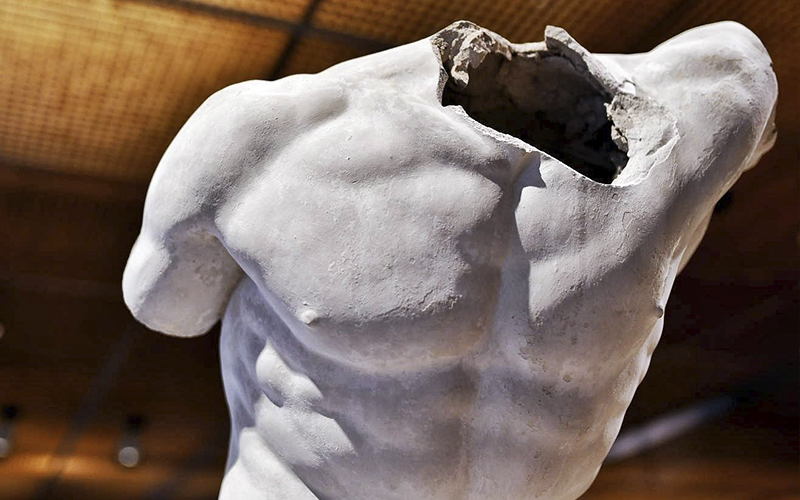
Infinite Sculpture
From the Antique Cast to the 3D Scan
Event Slider
Date
- Closed on Tuesday
Location
Main Gallery Calouste Gulbenkian FoundationThis exhibition brings together works by 18 contemporary artists and casts from the collection of the Faculty of Fine Arts of Lisbon. It takes a close look at casting, and the role it plays not only in sculpture, but also in many aspects of the everyday world.
Casting has been a way to make copies from other artworks, from life, from nature, from buildings, in the past and in the present. Casting in plaster still happens, but the exhibition has many more modern technologies on show, including 3D printing.
These various methods, and materials, all remind us that sculpture is rarely unique, and more often multiple. Casts are used to preserve special things and catch special moments that are about to change – children growing up, the face of the deceased, an important building – but are also used for everyday forms, such as domestic objects and homes.
Casts have long had an important documentary and especially medical function, and here the anatomy studio lies in between medicine and art as a space of learning
Alongside the historic casts we show works by David Bestué, Christine Borland, Marie José Burki, Steven Claydon, Michael Dean, Aleksandra Domanović, Asta Gröting, Simon Fujiwara, Oliver Laric, Jumana Manna, Jean-Luc Moulène, Charlotte Moth, Rogério Taveira, Francisco Tropa, Xavier Veilhan, Marion Verboom, Daphne Wright and Heimo Zobernig.
These artists have been chosen because they are fascinated by casting, and what it allows them to do. The exhibition is multi-layered, with no fixed narrative. Instead viewers will find endless links between old and new, centreing above all on the concepts of reproduction, variation, seriality, scale and commemoration.
Before travelling to Lisbon, this exhibition is on display at the Beaux-Arts de Paris until 16 February 2020, bringing together the contemporary works with the French historic plasters, in a setting that is redolent of the role of the plaster cast and its place in artistic learning.
This project is an opportunity to make available to the public collections from art schools that have aroused growing interest among researchers and contemporary artists, but have until now been almost entirely hidden from the public gaze.
Curatorial team: Penelope Curtis, Rita Fabiana, Thierry Leviez, Armelle Pradalier
Exhibition organised and co-produced by the Calouste Gulbenkian Foundation and the Beaux-Arts de Paris, in collaboration with the Faculty of Fine Arts of the University of Lisbon.
VIEW OF THE EXHIBITION
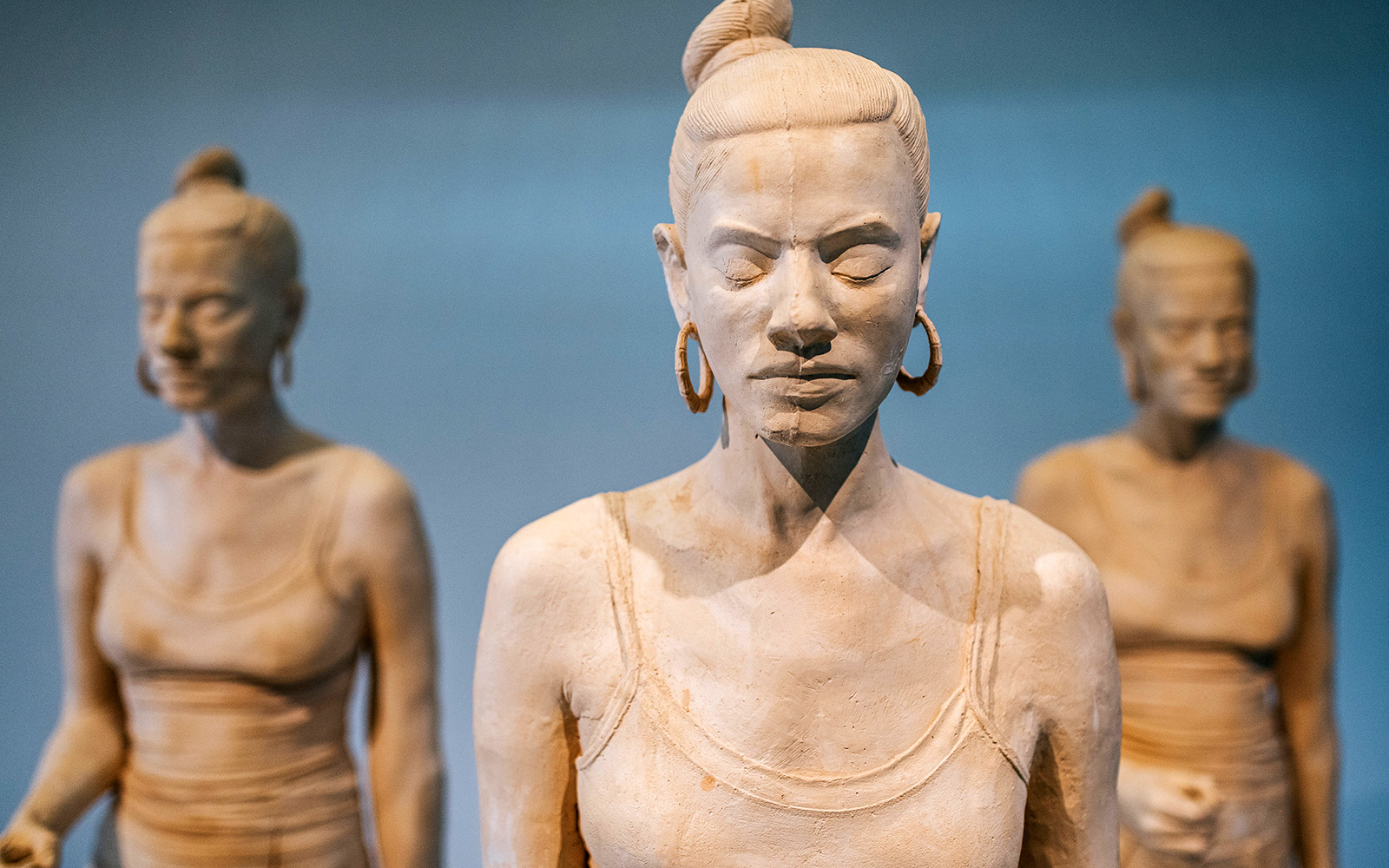

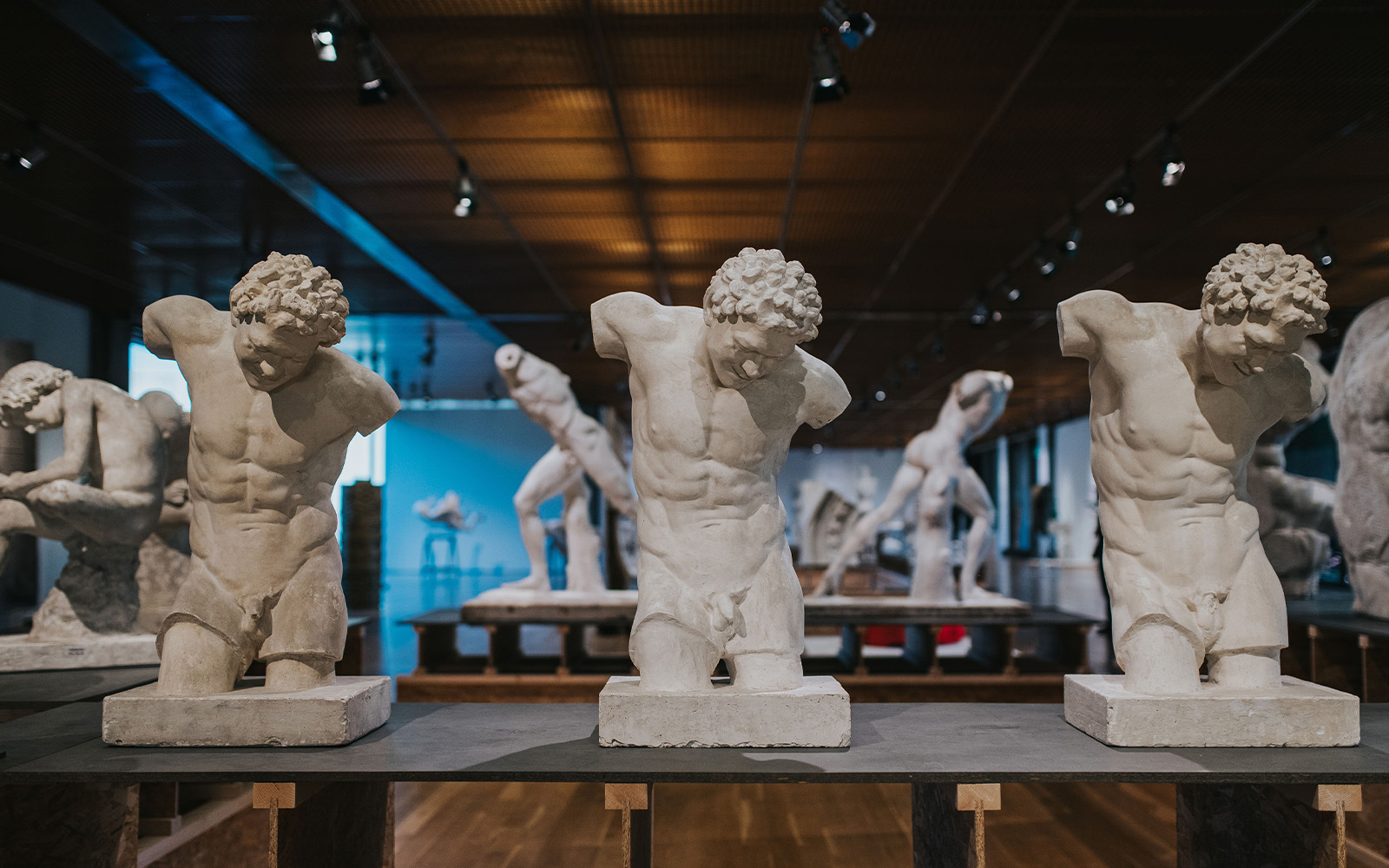
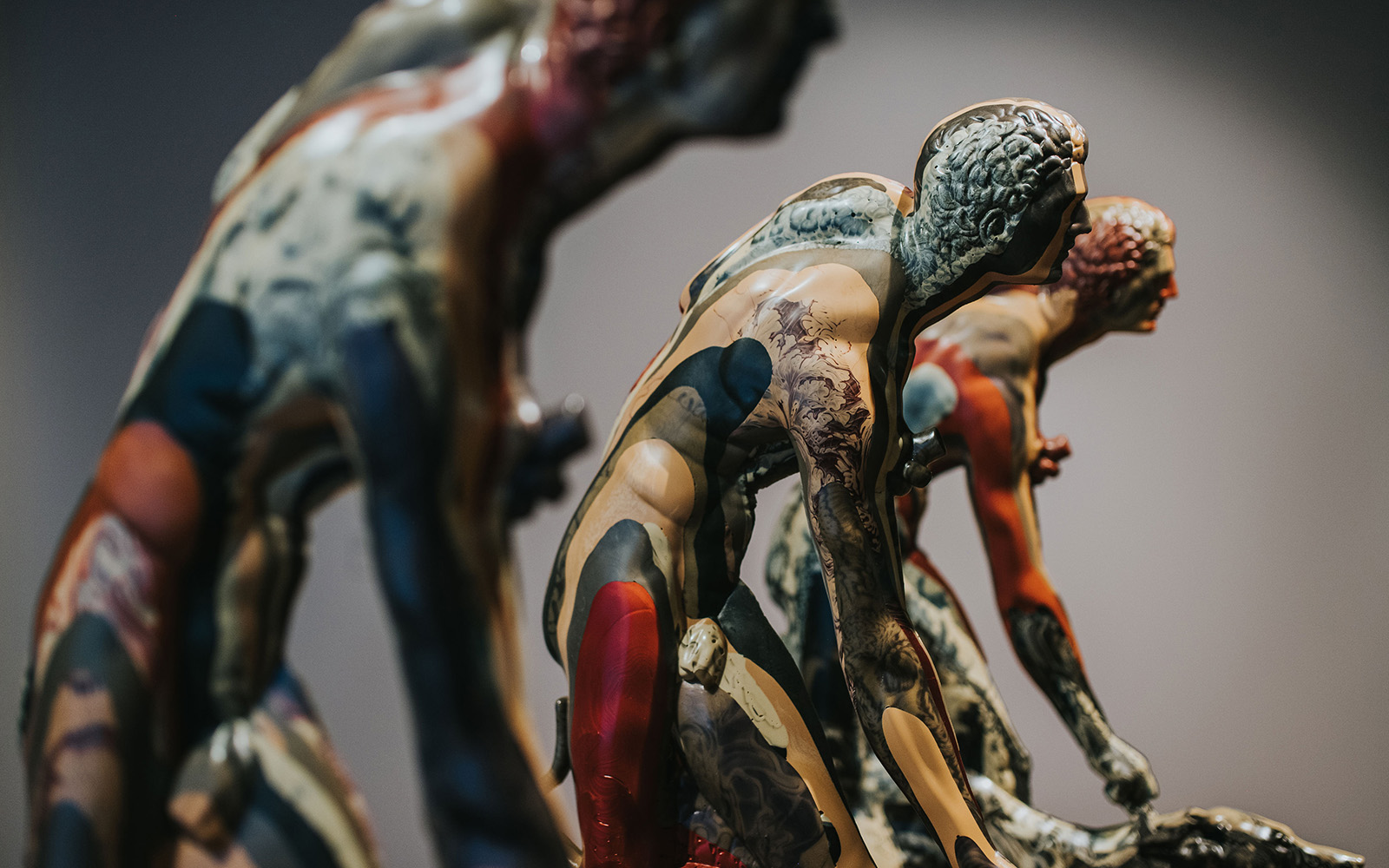
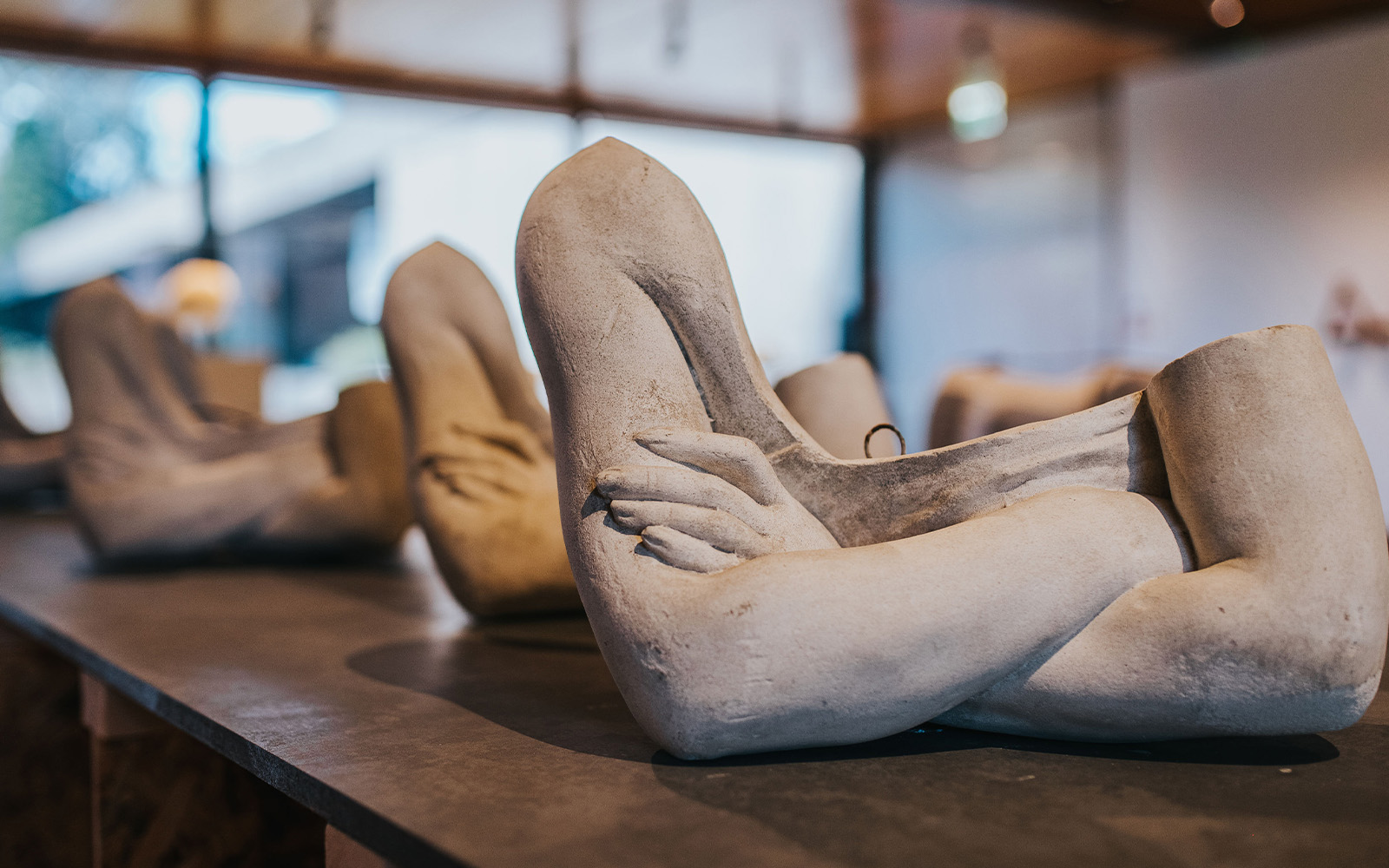

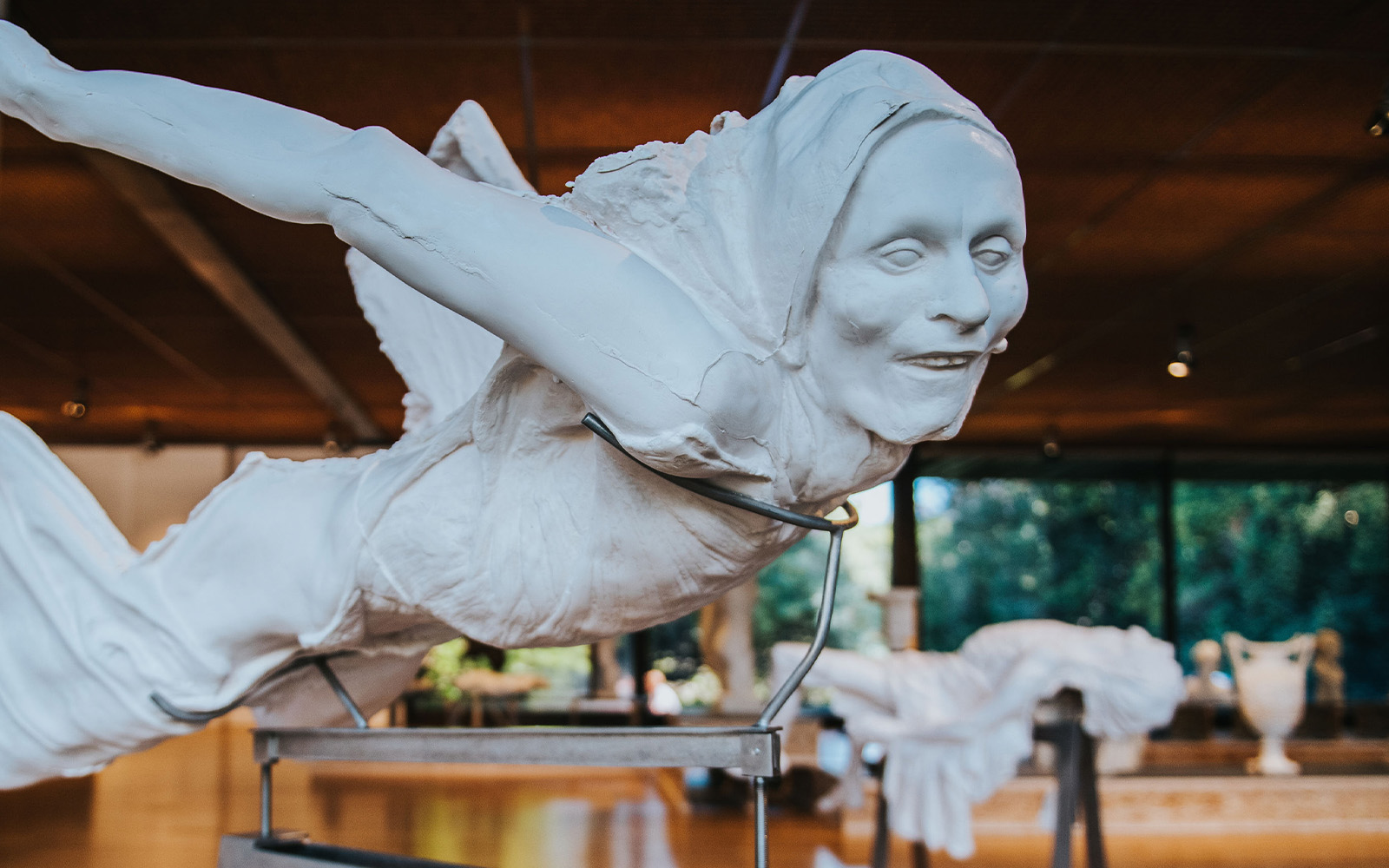
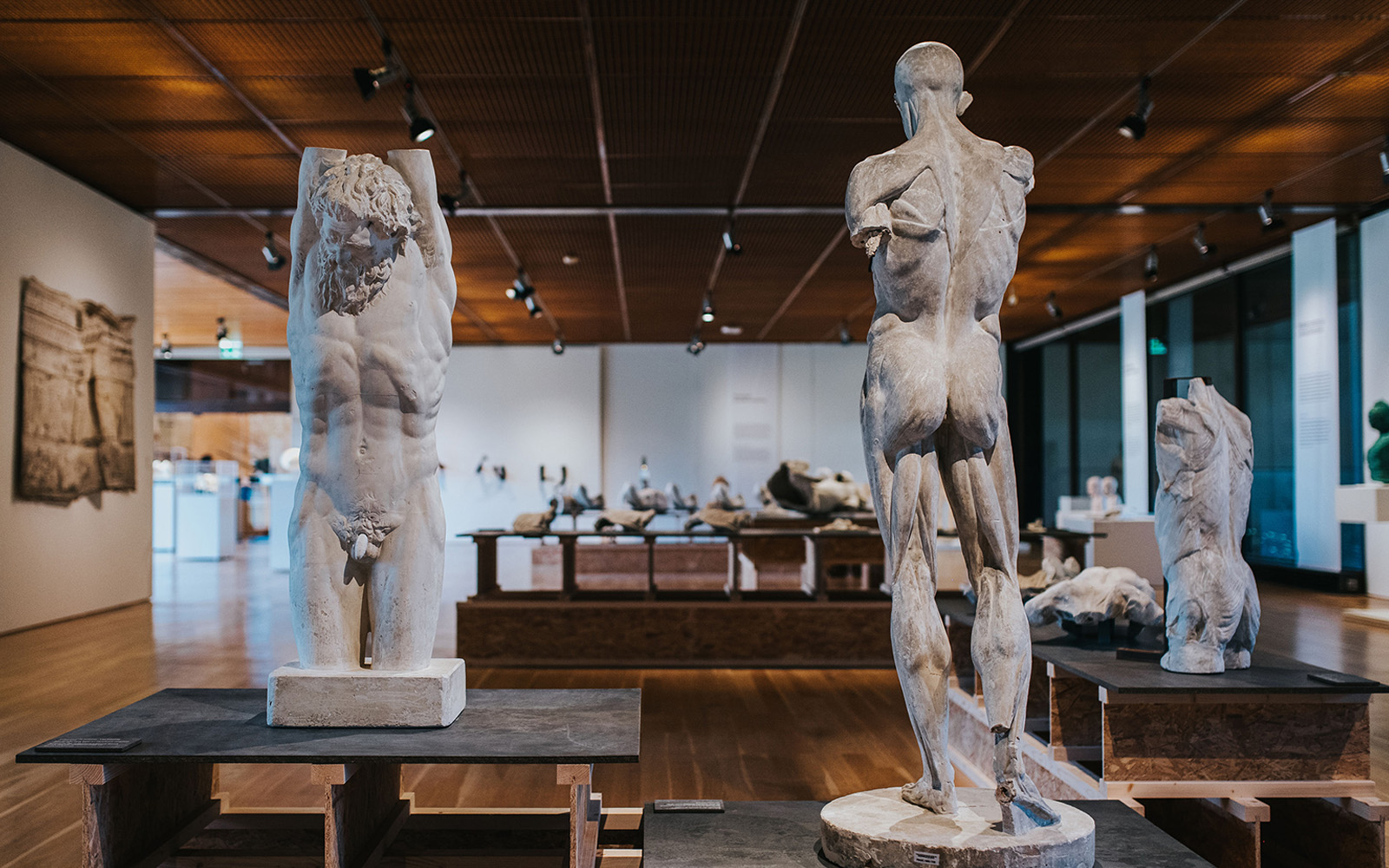

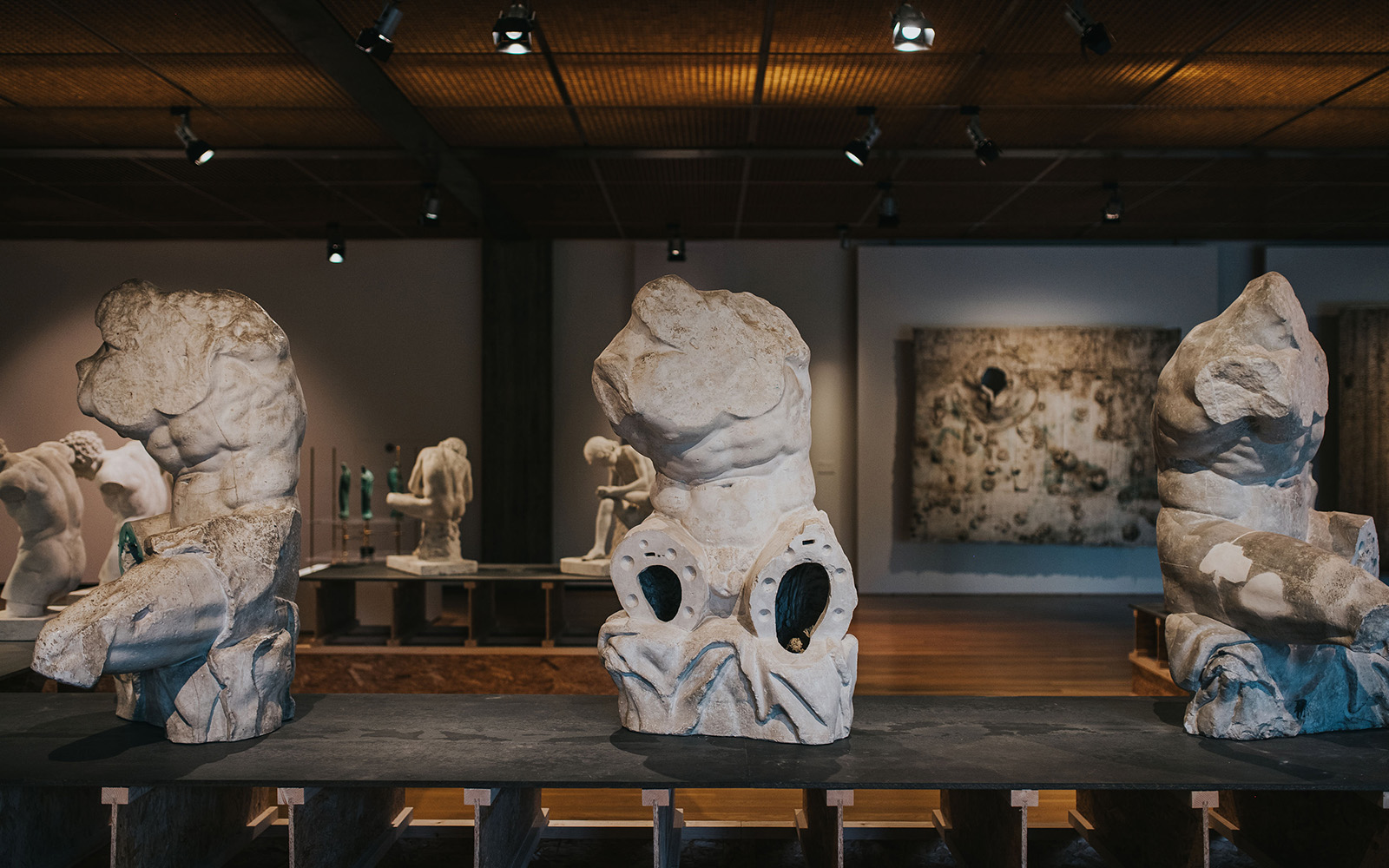

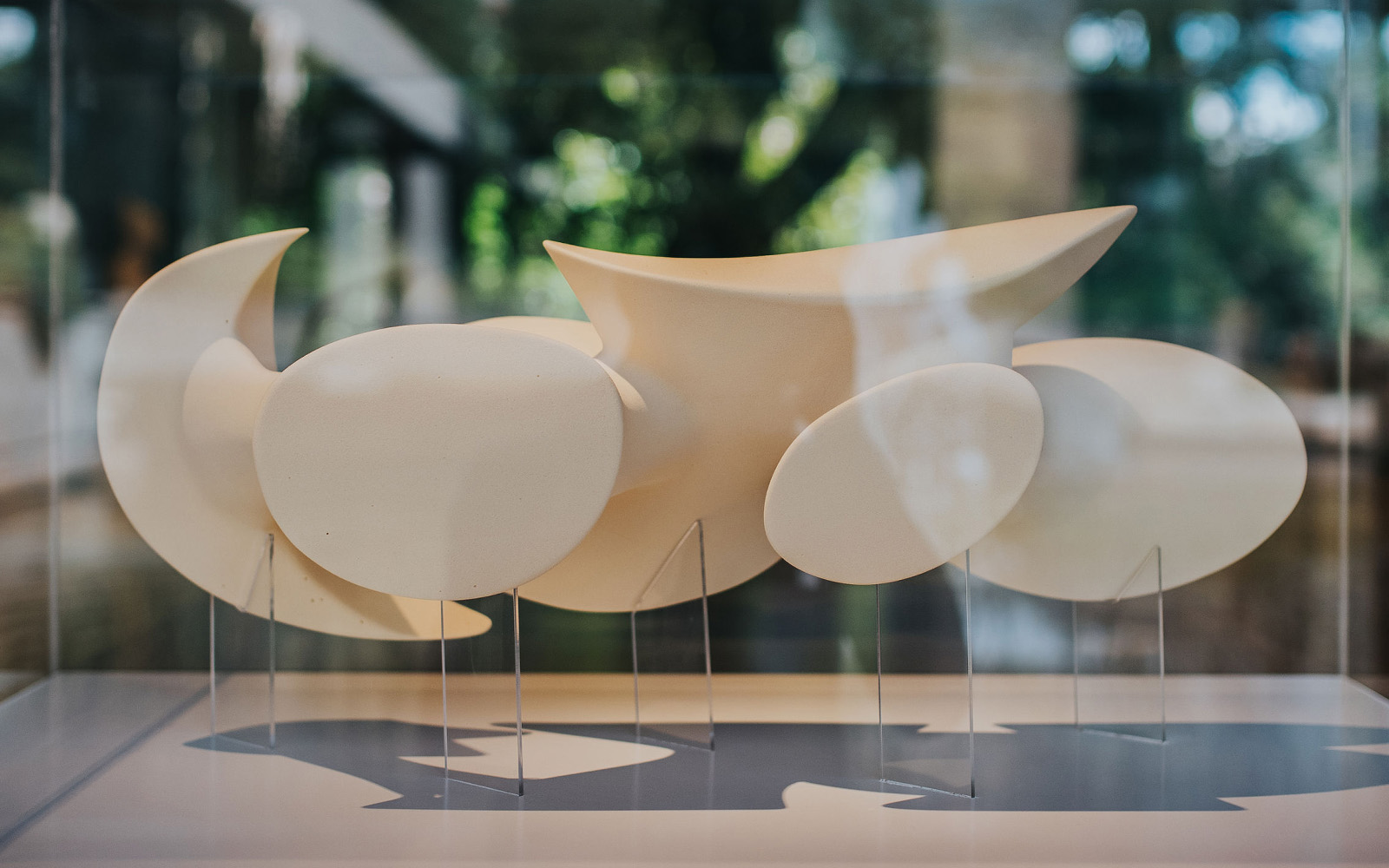
VIDEOS
Discover some of the most emblematic works through the voices of the curators: Penelope Curtis, Thierry Leviez, Armelle Pradalier e Rita Fabiana.
ARTISTS
Aleksandra Domanović was born in Novi Sad, in Serbia, in 1981. Part of her work is influenced by the modernist movement of post-war Yugoslavia, which produced various monuments to the revolution and unusual projects of human engineering. The fact her parents were doctors introduced her to biogenetics, another one of her influences.
Inspired by the ancient sculpture The Calf Bearer, discovered in the Acropolis, the work Kalbträgerin, which is on display here, stemmed from her interest in cloning, surrogacy and in vitro fertilisation, processes similar to the techniques of sculpture. The artist is interested in votive pieces, frequently reproducing hands with offerings, like animals or fruit.
Her fascination with one of the first attempts at prosthetic surgery, carried out in Serbia in the 1960s, combined with her interest in the votive sculptures that she saw on the Greek island of Samos, was the starting point for a series of sculptures that encompass elements of medical engineering and religious iconography.
The artist has created several pieces, including the work Substances of Human Origin, an ode to the modern techniques of digitalisation at the service of medicine, and a set of hands carrying out various tasks, including Fatima, a work conceived for the exhibition ‘The Future Was at Her Fingertips’, in Berlin.
Asta Gröting was born in Herford, in Germany, in 1961. She works with various mediums, from sculpture and installation to performance and video. Her work often focusses on invisible elements, such as the inside of a bullet hole, the digestive system and the spaces between two bodies, whether they be lovers, family members or historical figures.
The exhibition brings together four works from the series ‘Berlin Fassaden’, which consists of large-scale reproductions of the façades of buildings in Berlin damaged by bullets and other projectiles during the Second World War. Symbols of the destruction of material heritage and severe loss of life, these copies in silicone and jute were produced by moulding the surfaces of buildings directly.
As in photography, the artist subjected the silicone moulds to a long exposure, capturing all of the details, including dust, fragments of brick, lichen, traces of graffiti, small holes and large impacts.
This series is also a documentary record, a gesture of resistance against the oblivion of history, since many of these buildings are now undergoing restoration which erases the marks of war.
Charlotte Moth was born in Carshalton, in the United Kingdom, in 1978. Her artistic practice is marked by a reflection on sculpture and architecture, in the context of the modernist legacy. One of the modernist architectural spaces she evokes is the exhibition space itself, which the artist critically incorporates into her works. Sculpture, together with photography and film, represents an important part of her work.
The three sculptures presented here, Living Images, integrate a set of seven bronze pairs of hands, moulded from those of the artist, which hold found objects, from the everyday. Attached to the wall and displayed together, these sculptures create an illusion of almost cinematic movement, which is expressed in the title of the work.
The relationship between organic and inorganic appears once more in the work Lurking Sculpture (Rotating Rubber Plant). Its monochromy and the integration of a marble plinth in the piece appear to attribute it the traditional status of sculpture. However, in her work the artist seeks to deconstruct the concepts and codes with which we perceive artistic objects. Thus, the fact that the ‘plant’ is animated by a motor that brings it movement and life calls into question the characteristic immobility of traditional sculpture.
Christine Borland was born in Darvel, in Scotland, in 1965. She has used the technique of casting since the beginning of her career, focussing on its potential in the area of forensic medicine. In 2010, the artist came across an old mould of a dissected body arranged in a pose that resembled Michelangelo’s Pietà. She produced replicas of this piece, exhibiting one version in the original pose and another upside down, as if it were flying. These two figures displayed in the exhibition ‘Cast from Nature’ represent life and death.
The artist has maintained a keen interest in the connections between art and medicine, as well as their mutual influences. Plaster continues to be her material of choice, not just because of its associations with death, but also due to its ability to question our rapid acceptance of certain forms and poses, observing their dark side.
More recently, the artist developed a project using the work of sculptor Barbara Hepworth, making digitalisations of all her hollow pieces, creating new sculptures from the spaces inside the originals, literally turning the sculpture inside out. The work Positive Pattern, displayed here, is an example of this.
Daphne Wright was born in Ireland in 1963. She began using the technique of casting in her work in the 1990s. The artist is known for her installations, which make use of various techniques, such as photography, video and sound installation. Her themes of choice include growth, ageing and death.
The work Primate, displayed here, is part of a series of reproductions of animals immediately after death, in the manner of death masks. The monkey’s fur is recreated using detailed embroidery with silk thread, making it appear more realistic.In turn, the work Sons is a portrait of the artist’s children, the objective of which was to preserve the image of their transforming bodies, in an attempt to make time stand still. The sculpture evokes a funerary statue, creating a sensation of proximity, but also strangeness, accentuated by details like the touches of colour on the faces, carried out by a painter of religious statues.
Some of the artist’s works demand a lot of time for their execution, requiring the assistance of specialised artisans. While the pieces are initially cast in plaster, the artist goes on to mix synthetic resins and to replace plaster with marble dust.
Artist and writer David Bestué was born in Barcelona, in Spain, in 1980. He works primarily in the fields of sculpture and installation. In recent years, his work has begun to critically analyse the history of Spain and the developments that characterised the avant-gardes of the past century, especially in the spheres of architecture and engineering.
His works frequently evoke his country of origin, either through the use of materials from historic places or through literary references, particularly to Spanish poets from the first half of the 20th century.
Occasionally, the artist incorporates images or prints in his sculpture that are reminiscent of significant and sometimes disturbing events, such as references to Cuelgamuros, the site of the Francoist memorial ‘the Valley of the Fallen’ and Atocha Railway Station, the target of a terrorist attack in 2004. In the works on display in this exhibition, we come across elements from a beach in Valencia, remains from Toledo Cathedral and soil from Delphi.
The materials used are extremely diverse, including organic components, like plants and fruit, and objects of a more industrial nature, like vases and pieces of furniture.
Francisco Tropa was born in Lisbon, in Portugal, in 1968. He has worked in the fields of sculpture, drawing, installation, photography, film and performance. The works gathered here have as their starting point the process and place of foundry, as well as the sculptural pieces that inhabit this space, a genuine repository of forms.
The ‘hollow’ or ‘empty space inside a sculpture’ gives shape to the interior of another work. Starting with a sculpture of the Virgin and Child, the artist has produced a mould of the area between the two figures, the empty space between them.
The piece Penelope represents one of the founding figures of classical European culture and consists of four objects, once again the empty space inside a sculpture. The artist repeats the process four times, creating increasingly thin pieces, in a continuous exercise of reduction. Penelope represents the anxiety of waiting, intensified by the repetitive movement of a rotating motor.
The work Republic is also the process of giving visibility to the empty space inside a bust representing the French Republic. The artist reveals the interior of the Republic, literally and symbolically, questioning its political strength and the values of liberty, equality and fraternity.
Heimo Zobernig was born in Mauthen, in Austria, in 1958. In his work, he has sought to embrace all types of artistic vocabulary, making use of abstract painting and sculpture in particular. He has only recently dedicated himself to the problem of the figure.
The work presented by the artist in this exhibition is inspired by the female figure created by Georg Kolbe for the pavilion of Mies van der Rohe in Barcelona. Initially conceived for the Austrian pavilion in Venice, it never came to fruition. However, when he adapted this project for the Kunsthaus Bregenz, Zobernig had the opportunity to reorder it floor by floor and install a human figure on the top level of the building.
With its disturbing appearance, Zobernig’s piece recalls a science fiction character, due to the presence of the channels that were used in casting to ensure that the molten bronze reached all the points of the mould at the same speed. Created from digitalisations of three pre-existing sculptures, the figure is a kind of cadavre exquis.
A third exhibition of the project enabled Zobernig to take his relationship with the figure even further, producing a bronze mould that combines pre-existing figures, emphasising their singularity rather than their reproductive potential.
Jean-Luc Moulène was born in Reims, in France, in 1955. His interest in casting dates back to his school years, when he experimented with plaster, later substituting it with silicone because of its flexibility.
The masks displayed here were cast from carnival masks suspended underneath a table. The concrete was poured slowly, creating faces with elongated features that bear a clear resemblance to death and terror masks; they have even been associated with victims of decapitations by the Islamic State. Together, they form a national portrait gallery and some of them represent well-known personalities.
For the production of Indexes, the artist was inspired by the statuary of French gardens. He acquired second-hand copies and cut them using a laser, recombining the fragments to create new pieces. Other examples bring together natural elements and man-made objects, which the artist digitalised to study, subsequently casting them in resin as whole pieces and painting them, like in the work Bloc Rouge 1.
To create Knot 0.1. varia 02 Moulène tied a knot, pressed it into clay and tightened it until it broke, casting the resulting form using the lost-wax method. The wax occupies the space of the cord and is pushed out when the bronze is added to the mould. The artist produced other copies in bronze and glass.
Jumana Manna was born in Princeton, in the USA, in 1987. Her training in the area of sculpture, combined with her interest in historical places, explains why casting has become so important in her work. As a Palestinian, she has developed a sensitive relationship with certain places, especially when these are close to her in cultural terms, but inaccessible for political reasons, namely archaeological sites of Jerusalem.
The body and its functions mark some of the artist’s installations. The forms she chooses tend to be of an anatomical nature – armpits, shoulders, fingers and heels – evoking the ‘cemeteries’ of classical sculptures where limbs and extremities of bodies accumulate.
The works Armpit and Armpit Shell, which are displayed here, are a continuation of the series ‘Muscle Vases’. Together with the work Torso II, these pieces recreate a sauna environment, exploring our relationship of familiarity with the inner parts of our bodies, to which the artist gives expression and volume, exaggerating their features and amplifying the sounds they make.
In addition to sculptures, Manna produces films, normally using the two mediums in parallel. The installation on display in the exhibition also features two short animations on loop, Flutter and Balls.
Marion Verboom was born in Nantes, in France, in 1983. Her interest in materials, assemblage and architecture has provided her with an understanding of the properties of raw materials and the problem of architectural composition. Her works, essentially drawings and sculptures, include motifs of ancient architectural orders and stylistic elements of various periods and civilisations, in addition to incorporating geological components, like crystals.
Dyed using coloured pigments, her works present both a sculptural and pictorial dimension. In recent installations, the artist has presented mural paintings in coloured cement, on top of which other works can be displayed, bringing the gaze to waver between surface and volume, setting and form, foreground and background.
The work conceived for this exhibition, which displays Graeco-Roman elements, is based on the tradition of chryselephantine sculpture, in other words, sculptures made of ivory and gold. These sculptures were very important in Ancient Greece, with the monumental statue of Athena in the Parthenon constituting a rare and famous example. In the work Tectonie, a gilded brass patina is applied to the bottom of the plaster mould to create a golden film. The piece is composed of ten sections, assembled vertically, which allow for multiple variations.
Michael Dean was born in Newcastle upon Tyne, in the United Kingdom, in 1977. He used casting for the first time to repair a doorframe and was impressed by how quickly the material set. The experience led him to implement it in his artistic work. His sculptures are normally the height of a person, moulded from pieces of flooring, plastic bags and other available materials.
They are colourful and covered in traces of his family, especially the hands of his children, but also their mouths and tongues. In the Victorian era, parents used to make moulds of their children’s hands to capture their innocence, a stage in their development. They also made moulds of the hands of children who died. Dean’s sculptures shout, curse and cry. The children’s hands, which take the shape of small fists, gesticulate incessantly. Before developing the type of sculpture he produces now, Dean primarily cultivated a practice based on writing and performative texts. Currently, his poetry results in human forms that are much more troubled and visceral.
Oliver Laric was born in Innsbruck, in Austria, in 1981. Like many artists of his generation, he is interested in the circulation of information on the Internet, producing work focussed on repetition, exploring meme culture, the reuse of the same shot or scene in different films and even the reproduction of sculptures.
The need to transfer his research to the physical space gave rise to his first sculptures, although many of his works continue to be published first online. The two works exhibited here are copies of pieces by British sculptor John Gibson, with changes made by Laric. The artist’s fascination with Gibson’s works is due to their repetition: the work The Hunter and His Dog, for example, reappeared on a set of the 2015 Eurovision final, as well as appearing as a hologram in the music video of an American pop group and, more recently, on the set of a German dance contest.
The artist’s Sleeping Boy was inspired by Gibson’s work Sleeping Shepherd Boy, which the sculptor himself reproduced countless times in the 19th century to give to visitors of his studio. Like Laric, Gibson made changes to his copies, creating numerous variations of the same work.
They are colourful and covered in traces of his family, especially the hands of his children, but also their mouths and tongues. In the Victorian era, parents used to make moulds of their children’s hands to capture their innocence, a stage in their development. They also made moulds of the hands of children who died. Dean’s sculptures shout, curse and cry. The children’s hands, which take the shape of small fists, gesticulate incessantly. Before developing the type of sculpture he produces now, Dean primarily cultivated a practice based on writing and performative texts. Currently, his poetry results in human forms that are much more troubled and visceral.
Simon Fujiwara was born in Harrow, in the United Kingdom, in 1982. An architect by training, he explores the issues of duplicity and recurrence through a combination of performance, sculpture and installation. His complex narratives explore the concepts of history, memory and identity and are frequently critical of society's obsession with the self-representation offered by new technologies. His works often involve elements of pop and mass culture and the artist regularly collaborates with the entertainment and advertising industries.
The work Rebekkah was the result of an invitation to the 9th Shanghai Biennale. Responding to the challenge, the artist invited a British sixteen-year-old who had participated in the 2011 London riots to accompany him on a trip to China. The two weeks ended with a visit to the famous Terracotta Army in the Mausoleum of the First Qin Emperor. Taking advantage of local resources, Fujiwara produced approximately one hundred versions of Rebekkah, which would be presented at the Biennial as reproducible forms of a contemporary historical figure. The installation is accompanied by a video which, in the style of a television report, documents the teenager’s travels in China.
Artist and musician Steven Claydon was born in London, in the United Kingdom, in 1969. He is famous for his multimedia installations, which are full of external references. Casting is one of the artist’s preferred techniques, enabling him to create forms that appear distant in space and time.
The work Voyager Assembly, for example, combines various references: the assemblage revolves around Dying Seneca, an ancient sculpture restored in the Renaissance, in which the figure of a fisherman was transformed into a thinker. The artist proposes an enlarged version of the figure, replacing part of the head with the cast of a futuristic character from the film Demolition Man.
The work Persistent Vestibules, in turn, brings together various materials that produce a ‘museum of hybridisation’, composed of a skydiving harness, decorative panels from a Tudor mansion, a medieval sculpture and a circular relief inspired by the film Solaris.
The last work by the artist in the exhibition, Compound Chimera (Survivalist), is based on a sculpture from the Hellenistic period, Boy with Goose. The artist put a cast of this sculpture on a pile of monochromatic palettes, in a reference to minimalism, crowning it with a circular form.
Some of his references are explicit, others remain hidden, adding complexity to the work and protecting it from didactic interpretations.
Xavier Veilhan was born in Lyon, in France, in 1963. His multifaceted work encompasses a range of mediums from painting and sculpture to installation and performance. The artist is well-known for his interventions in space, altering the way it is perceived by the spectator. His material research is often accompanied by musical collaborations and the artist has portrayed several famous musicians.
The series of works entitled Laurent were based on a live model digitalised in 3D. Produced at different times, each piece demonstrates variations, in the orientation of the head, the choice of materials or scale, for example. The exhibition features two versions of this sculpture, whose triangular surfaces give them the appearance of a manufactured product. The digital tools produce a schematising effect, but the artist seeks to preserve the singularity of the model, avoiding symmetry.
The sculpture-personality Aina, initially exhibited in the Barcelona Pavilion of Mies van der Rohe and Lilly Reich, together with three other versions, attempts to recreate and modernise the pose of Alba, a female nude by sculptor Georg Kolbe.
Topics


Casts after antique sculpture

Casts after monuments

Capturing time

Casts from life

Anatomy lessons

Endless reproduction

Discovering the interior

Materials: past and present

Size and repetition
-
The art school
The scenario of this exhibition evokes the fascinating disorder of the art school which, unlike a museum, is not constrained by standard categorization, allowing us to discover surprising combinations: art next to science, architecture next to nature, small next to large, old next to new. In contemporary art schools, artists still work with and surrounded by casts.
This exhibition aims to throw light on a source of inspiration which is often invisible to the general public.
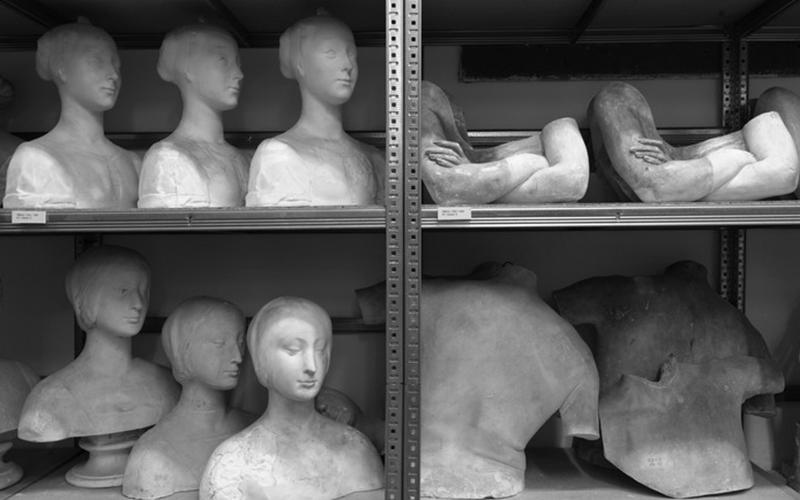
- Plaster cast collections of the Faculdade de Belas-Artes da Universidade de Lisboa. Photo: Carlos Azevedo 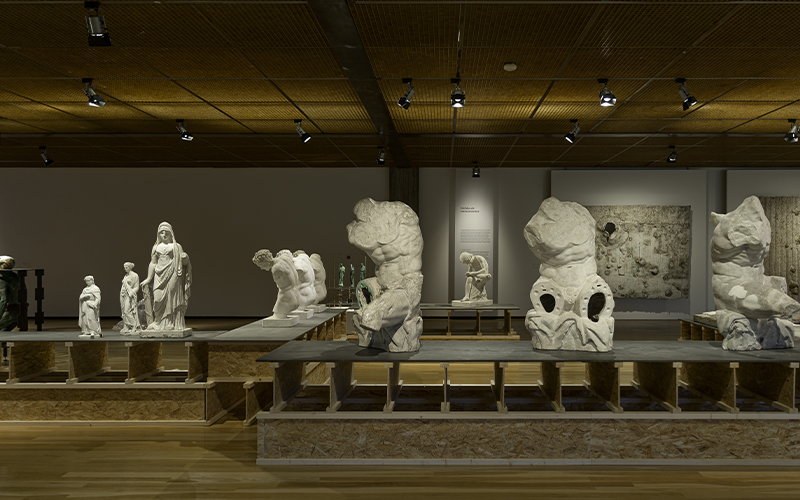
View of the exhibition Infinite Sculpture. From the Antique Cast to the 3D Scan. Photo: Ricardo Oliveira Alves -
-
Casts after antique sculpture
In Renaissance Italy excavations began to uncover sculptures from classical Greece and Rome. The excitement generated by such finds led rich patrons to commission plaster casts. In the 19th century schools and museums built up large collections of such casts for educational purposes.
Although they fell from favour when they were no longer seen as ‘original’, a new interest in the cult of the copy has recently restored their popularity.
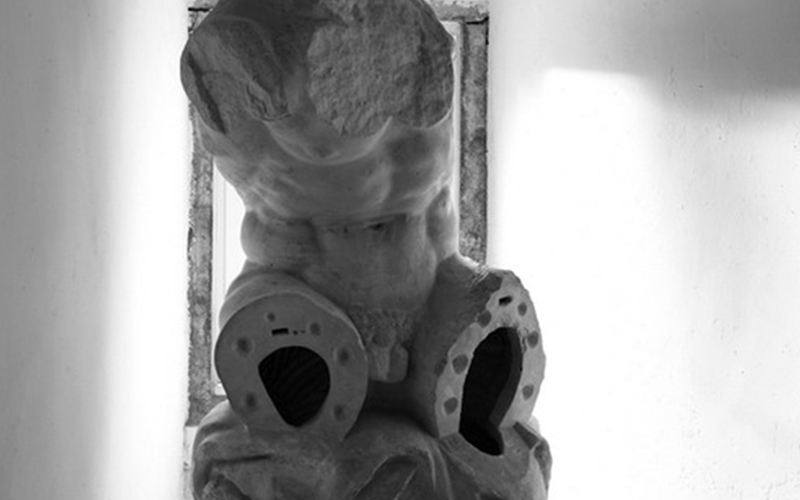
Plaster cast collections of the Faculdade de Belas-Artes da Universidade de Lisboa. Photo: Carlos Azevedo 
Plaster cast collections of the Faculdade de Belas-Artes da Universidade de Lisboa. Photo: Carlos Azevedo 
View of the exhibition Infinite Sculpture. From the Antique Cast to the 3D Scan. Photo: Ricardo Oliveira Alves 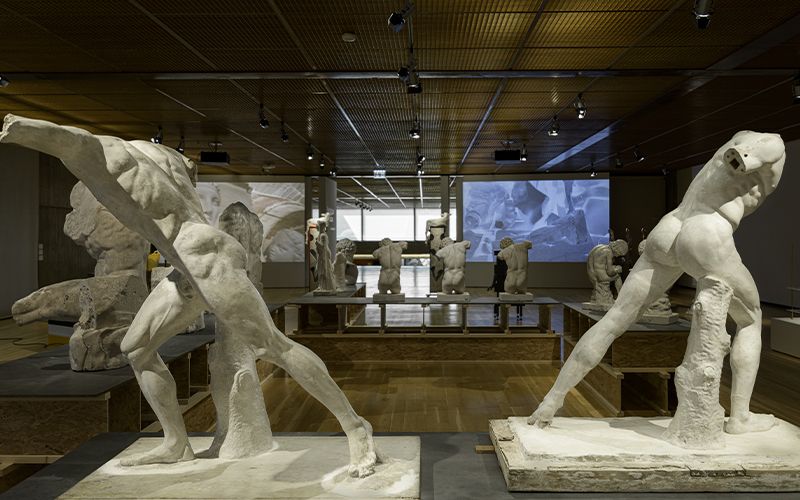
View of the exhibition Infinite Sculpture. From the Antique Cast to the 3D Scan. Photo: Ricardo Oliveira Alves -
-
Casts after monuments
The impossibility of transporting buildings promoted the multiplication of plaster casts of famous classical monuments, giving them mobility and contributing to an interest in documenting national patrimony, since these new techniques allowed the preservation of the state of the pieces at a particular time.
Casts have preserved structures that would otherwise be lost, like buildings destroyed by war or by modernisation.
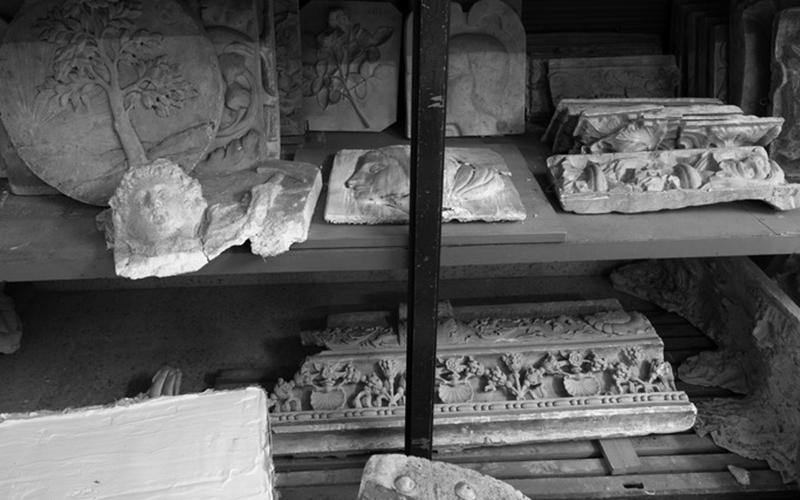
Plaster cast collections of the Faculdade de Belas-Artes da Universidade de Lisboa. Photo: Carlos Azevedo 
Plaster cast collections of the Faculdade de Belas-Artes da Universidade de Lisboa. Photo: Carlos Azevedo 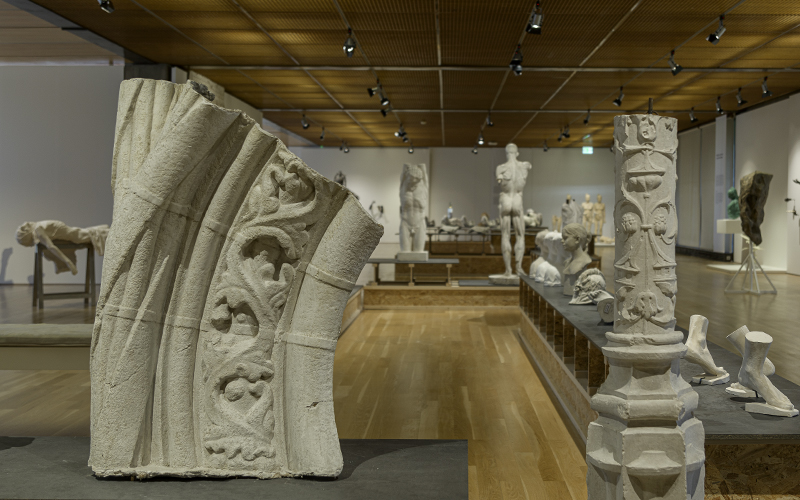
View of the exhibition Infinite Sculpture. From the Antique Cast to the 3D Scan. Photo: Ricardo Oliveira Alves 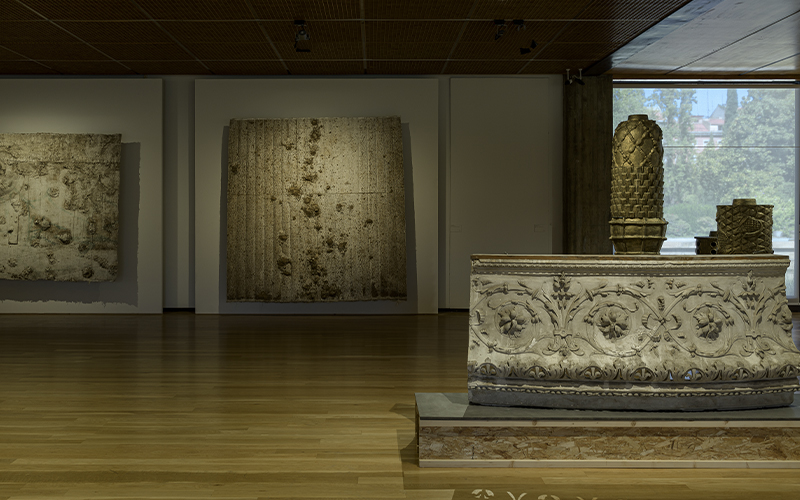
View of the exhibition Infinite Sculpture. From the Antique Cast to the 3D Scan. Photo: Ricardo Oliveira Alves -
-
Capturing time
Besides allowing us to be closer to objects which are physically distant, plaster casts can also preserve intimate moments, by capturing a form before it alters or disappears, such as a particular phase in the growth of a child, an archaeological site or a façade.
Plaster casts have the ability to capture the transformations that a form goes through over time.
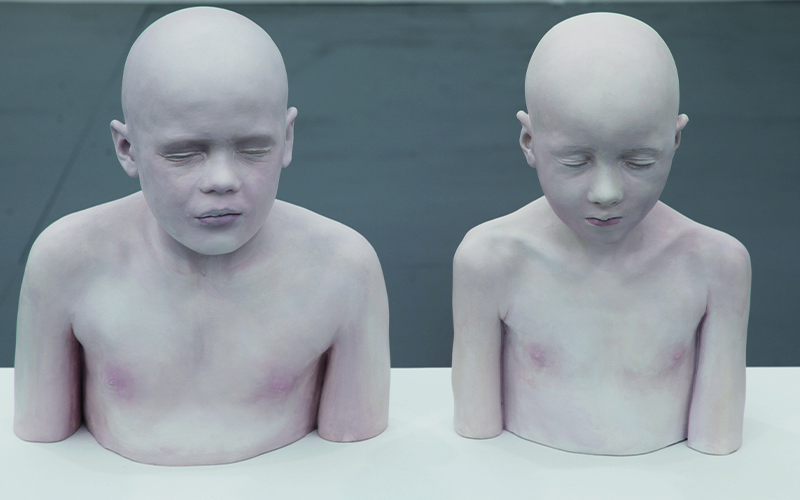
Daphne Wright, 'Sons', 2011. Jesmonite, paint. Courtesy Daphne Wright & Frith Street Gallery, London. Photo: All rights reserved 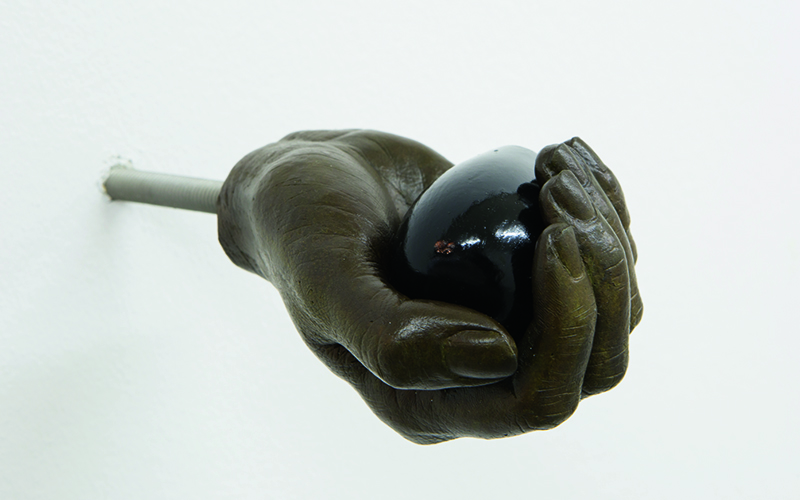
Charlotte Moth, 'Living Images (2)', 2015. Bronze, glass, doorknob. Collection Almine et Bernard Ruiz-Picasso. Photo. Aurelien Mole -
-
Casts from life
As it is a relatively simple process, casting allows the reproduction of many different things in amazing detail. In order to increase their repertoire, artists and architects started casting from elements of nature, like leaves and flowers.
There was also a fashion of casting from life the faces of famous people and the hands of musicians, writers and artists. The death mask is the ‘last portrait’.
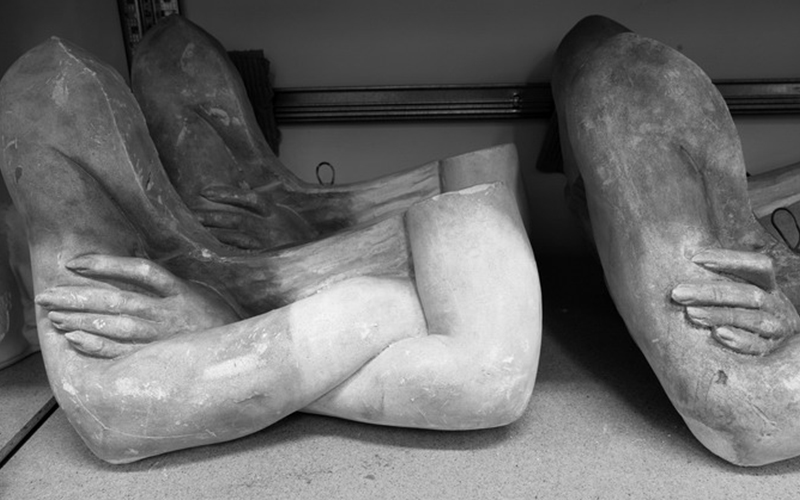
Plaster cast collections of the Faculdade de Belas-Artes da Universidade de Lisboa. Photo: Carlos Azevedo 
Plaster cast collections of the Faculdade de Belas-Artes da Universidade de Lisboa. Photo: Carlos Azevedo -
-
Anatomy lessons
In the 19th century plaster casts were often used for medical teaching. Contemporary artists have found this combination of art and science fascinating, noting how even corpses used to teach anatomy were artistically arranged, and how the sequencing of the casting process prefigures today’s cloning techniques.

Plaster cast collections of the Faculdade de Belas-Artes da Universidade de Lisboa. Photo: Carlos Azevedo 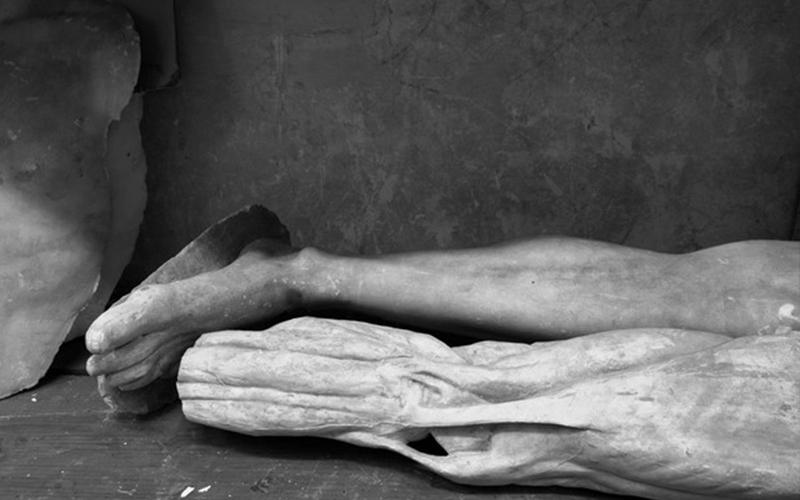
Plaster cast collections of the Faculdade de Belas-Artes da Universidade de Lisboa. Photo: Carlos Azevedo 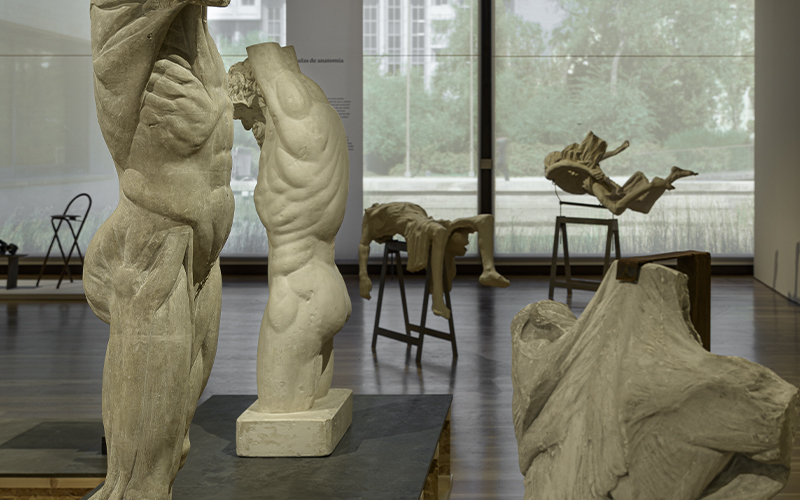
View of the exhibition Infinite Sculpture. From the Antique Cast to the 3D Scan. Photo: Ricardo Oliveira Alves 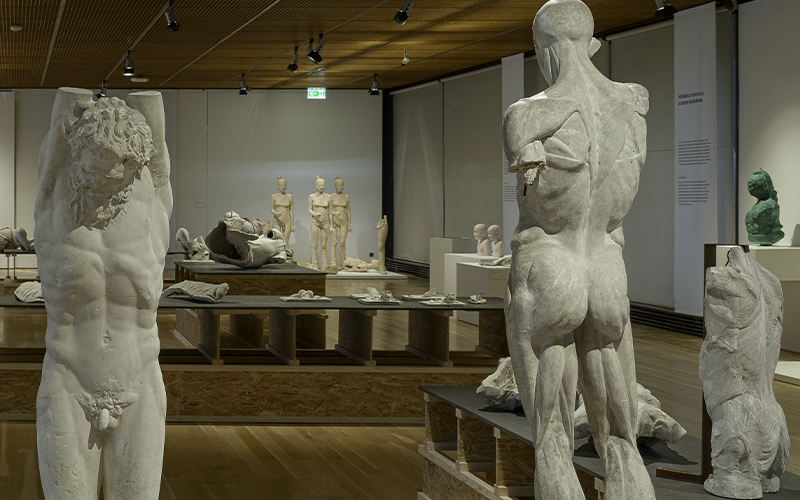
View of the exhibition Infinite Sculpture. From the Antique Cast to the 3D Scan. Photo: Ricardo Oliveira Alves -
-
Endless reproduction
Plaster casts make us think of famous classical sculptures, which were highly disseminated even before the days of virtual reality.
This kind of endless repetition is a key theme of this exhibition. Certain artists have focused on the reproduction of antique sculptures using ultra-modern techniques, making them available not only here, but also in a digital format.
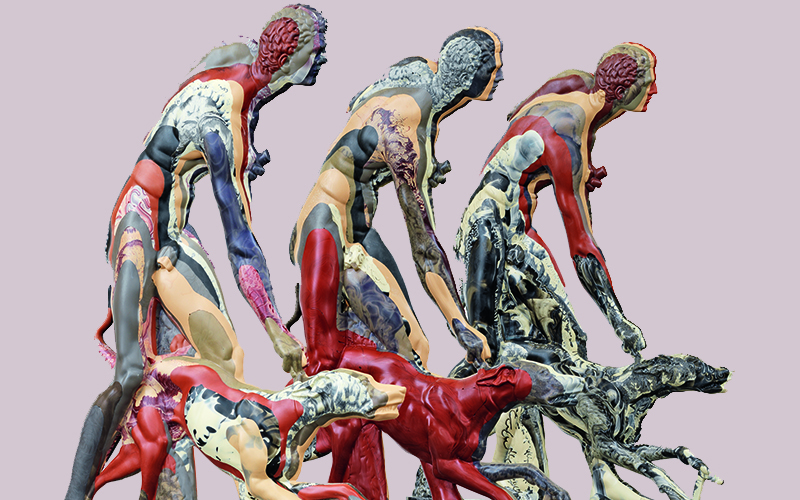
Oliver Laric, 'The Hunter and His Dog', 2015,polyurethane pigments, steel stand. Courtesy Oliver Laric, Zabludowicz Collection in collaboration with Tamares Real Estate. Tanya Leighton, Berlin. Photo: Gunter Lepkowski 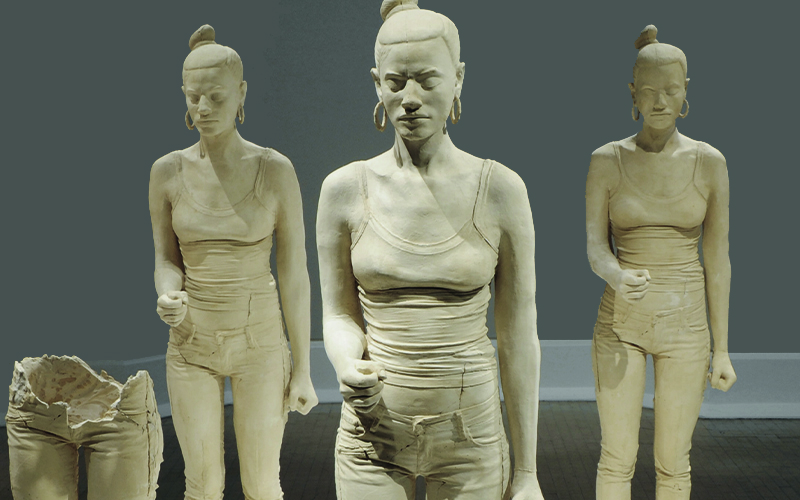
Simon Fujiwara, 'Rebekkah', 2012. Terracotta and dyed plaster. Leeds Art Gallery (The Contemporary Art Society Collections Committee). Photo: Leeds Museums and Galleries (Leeds Art Gallery) / Bridgeman Images 
View of the exhibition Infinite Sculpture. From the Antique Cast to the 3D Scan. Photo: Ricardo Oliveira Alves 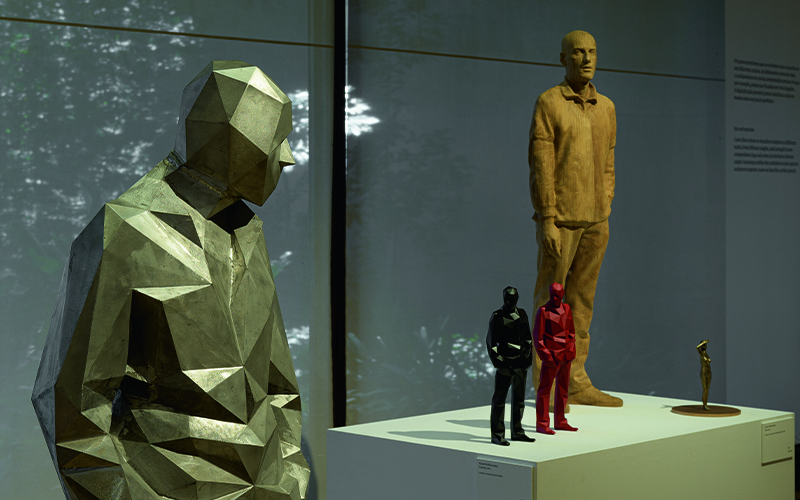
View of the exhibition Infinite Sculpture. From the Antique Cast to the 3D Scan. Photo: Ricardo Oliveira Alves -
-
Discovering the interior
To make a cast you need to make a mould around the original object, capturing its shape and surface. Contemporary artists use today’s liberty to focus on this form rather than the original image.
Digital scanning allows for the precise mapping of interior shapes, as does a tiny hidden camera, or the traditional casting process itself.
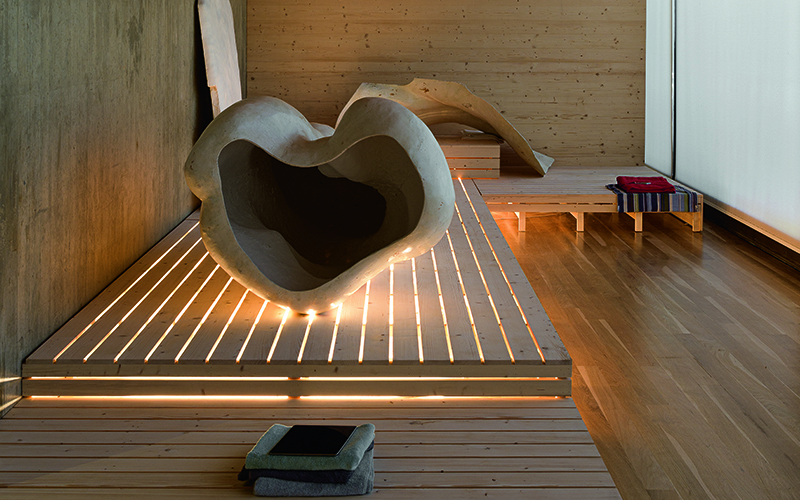
View of the exhibition Infinite Sculpture. From the Antique Cast to the 3D Scan. Photo: Ricardo Oliveira Alves 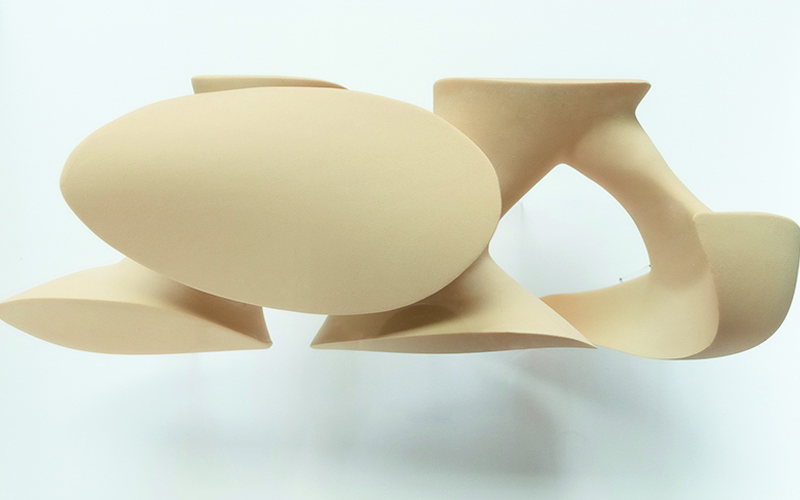
Christine Borland, 'Positive Pattern', 2016. Rapid prototype foam, Perspex, MDF, paint. National Galleries of Scotland. Purchased with the Iain Paul Fund 2017. Commissioned by the Institute of Transplantation, Newcastle. Photo: Ruth Clark -
-
Materials: past and present
Moulds take their shape from the original form and are generally made from plaster. Any liquid or molten material can be poured into them: plaster, metal – usually bronze – or, increasingly, plastics.
The mapping nowadays can also be undertaken in a laboratory, with a scanner, instead of in a studio, using plaster. The business of casting and copying has simply got cleaner.
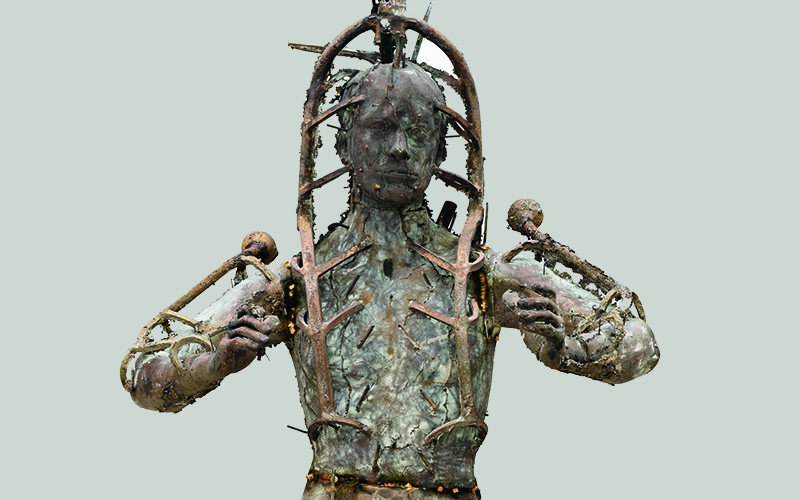
Heimo Zobernig, Untitled, 2015. Bronze, edition of 7. Collection Emmanuelle Guttman. Courtesy Simon Lee Gallery, London/Hong Kong. Photo: Todos os direitos reservados 
View of the exhibition Infinite Sculpture. From the Antique Cast to the 3D Scan. Photo: Ricardo Oliveira Alves 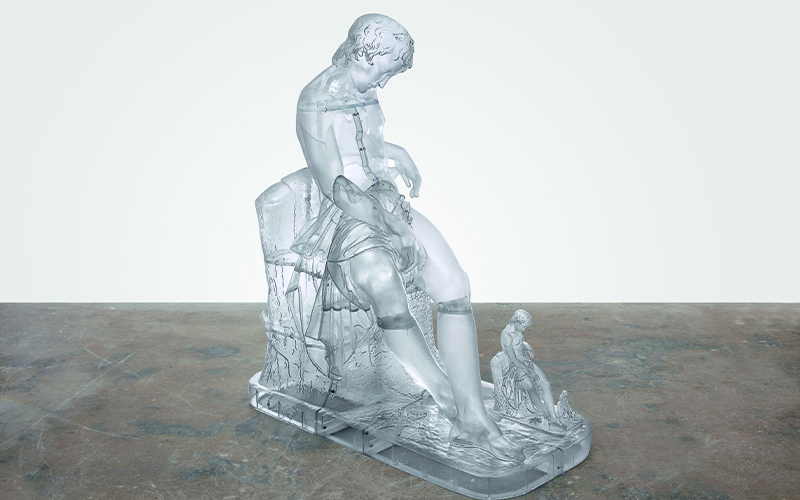
Oliver Laric, 'Sleeping Boy', 2016, stereolithography, Courtesy Oliver Laric, Zabludowicz Collection in collaboration with Tamares Real Estate. Tanya Leighton, Berlin. Photo: Gunter Lepkowski 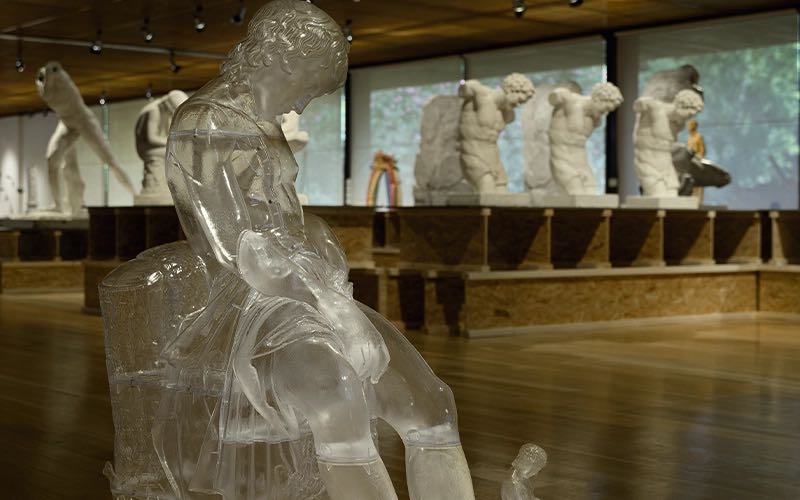
View of the exhibition Infinite Sculpture. From the Antique Cast to the 3D Scan. Photo: Ricardo Oliveira Alves -
-
Size and repetition
Casts allow artists to visualize sculptures at different scales, from different angles, and arranged in new compositions: legs and arms can be fixed at diverse angles. Scanning enables the technician to join separate sculptures together, more or less like a perfect puzzle.
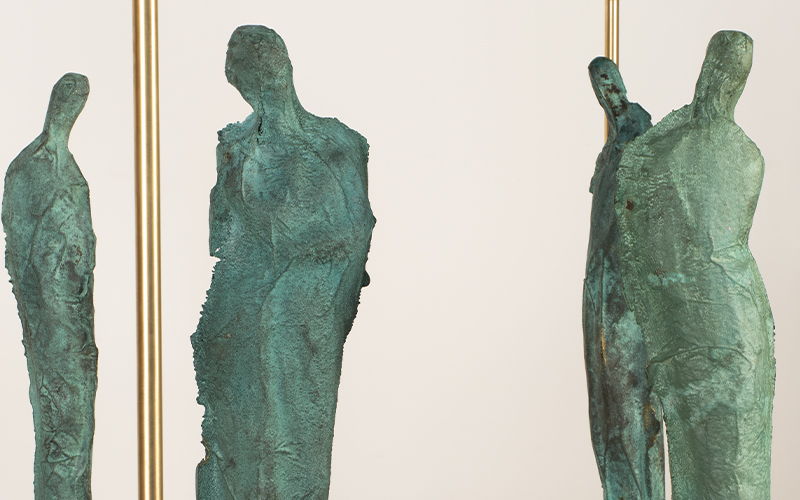
Francisco Tropa, 'Penelope', 2018. Bronze, metal pedestal and automatic rotation motor. Courtesy Francisco Tropa & Galerie Jocelyn Wolff. Photo: Teresa Santos 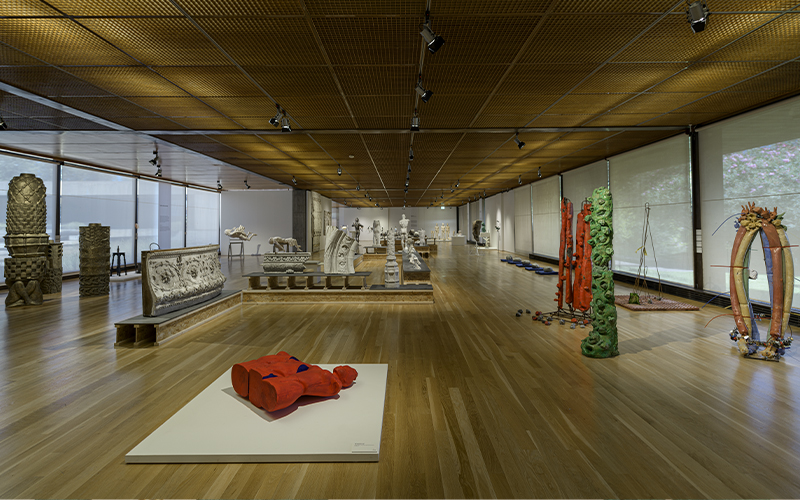
View of the exhibition Infinite Sculpture. From the Antique Cast to the 3D Scan. Photo: Ricardo Oliveira Alves -
Complementary Programs
‘The artists’ points of view’
With Penelope Curtis e Francisco Tropa, Belén Uriel and Rogério Taveira
Conversation in Portuguese without simultaneous interpretation
Thursday, 17 September, 15:00
Find out more
FREE AUDIO GUIDE
Get the Gulbenkian Museum App to access the free audio guide for this exhibition (in Portuguese and English).
